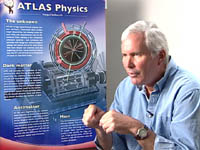Einstein's Dream of Unified Forces
Are there undiscovered principles of nature: new symmetries, new physical laws?

View the Video
Our quest to discover the fundamental laws of nature has led to the revelation that the laws of physics and the particles they govern exist because of underlying symmetries of nature, some of them lost since the big bang. One such lost symmetry might be supersymmetry. Just as for every particle there exists an antiparticle, supersymmetry predicts that for every known particle there also exists a superpartner particle. Part of the strong theoretical appeal of supersymmetry, an essential part of string theory, is its possible connection to dark energy and the fact that it provides a natural candidate for dark matter, the neutralino.
The discovery of supersymmetry is an immediate experimental challenge of particle physics, followed by the exploration of its structure and the properties of the superpartner particles. Particle accelerator experiments at Fermilab will help uncover the role of supersymmetry in a unified theory and reveal whether the neutralino superpartner accounts for dark matter.
Tools for a Scientific Revolution
The laws of nature derive from nature's symmetries; searching for new particles and forces means searching for new symmetries. One such symmetry might be supersymmetry, which predicts that for every known particle there exists a superpartner particle of the same mass. Experiments have not yet detected any of the superpartners; thus, if supersymmetry exists, it must be broken by unknown physics that makes superpartner particles heavy. Superpartner masses may be related to the Higgs field. Supersymmetry provides a natural dark matter candidate, the neutralino. Experiments are searching for supersymmetry; previously at the Tevatron and now indirectly at the B-factories Belle and BaBar.
The Tevatron may have had enough energy to produce detectable signals of the lightest superpartners, but the Large Hadron Collider should have enough energy to produce all or most of the superpartner particles, either directly or through the decays of other superpartners, to determine the pattern of superpartner masses and decays.
Theoretical models for the physical mechanism that breaks supersymmetry are already constrained by data from Belle and BaBar. Future precision studies at Belle and BaBar, as well as from the LHCb experiment will allow physicists to disentangle the flavor structure of supersymmetry through subtle changes to decays of B mesons.
Even farther down the road, a linear machine could complement the discoveries made at the LHC and measure the properties of the superpartners very precisely.
- Last modified
- 04/28/2014
- email Fermilab

